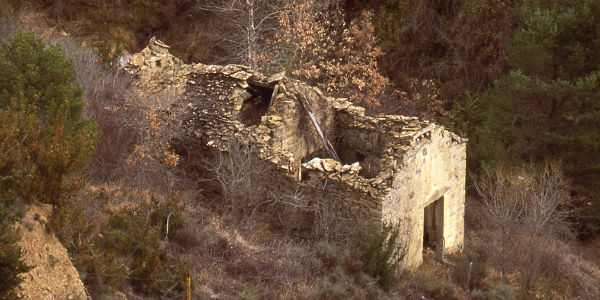Mills in Alto Aragón - central eléctrica
Yebra de Basa
Yebra de Basa,
is situated east of
Sabiñánigo in the valley of the Río Basa.
From the
Ermita de Santa Orosia
just outside the village walk the gravel road towards
the Santuario. Very soon there is a branch to the left leading towards the
Barranco de Santa Orosia.
Cross the water and then keep to the road. Do not follow the path anymore.
You'll first long the rivulet and then gain height. At some point you'll leave the fields and come into
unkept shrubland. It is before you reach the hair pins. Locate the view of picture 1 and try to work your way down.
Take care because there are some steep stretches.
Pictures: 01.i.2013

(2) Dam with waterfall
As the roof collapsed and the
construction was emptied from all its contents, there isn't much left to see. The building consists of two rooms of which
one (with the entrance) probably is a later addition: see the seam which is visible in pict. 4.
In the room at the back a socket made of concrete and with protruding screw bolts reveals where the generator
had its place. Apart from this, only two sets of insulators remain. One triplet (6) just below the
roof in the generator room and another triplet (5) where the wires left the building above the entrance.
A local magazine (
†) spent a few pages
on the history of this powerstation. We learn that the locals founded the
Sociedad La Electra de Santa Orosia
on January the 6th of 1924. Notice that this is at about the same time as several other villages in the wide region.
The society would manage the powerstation situated in the Barranco of the named saint in order to provide
fluido eléctrico
to the public.
The precious juice didn't come in large quantities and therefore suscribers had to comply
to firm, draconian even, rules which were enumerated in the Reglamento
dated August 12th, 1927. The subscription system was based on the number of light bulbs and it was strictly forbidden
to connect heavy users such as an electrical heater. Fines for doing so could reach the equivalent of a fortnight's wages!
It was also forbidden to switch to another type of bulb, nor was it
allowable to fit extra lights without the company knowing it. The first infraction could cost three days work and the
third four times this amount.
The company's staff had far reaching powers. They could come and check wiring
and appliances in any home at any time of day! If they were denied access they could disconnect you on the spot and
the company could of course not be held liable for any damage resulting from a power autage.







